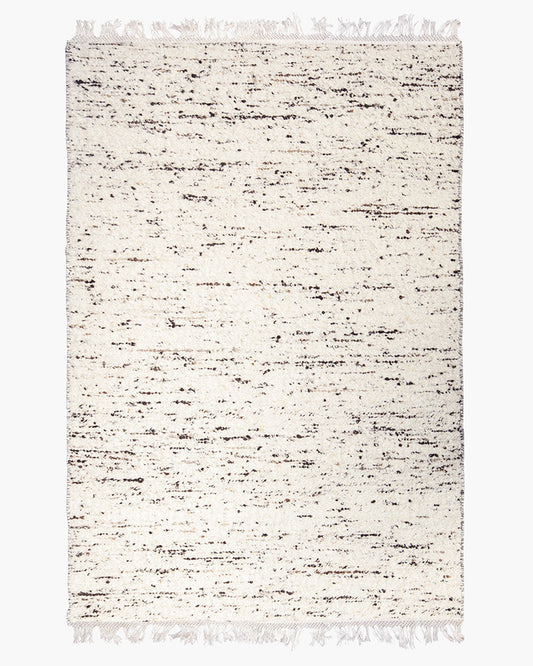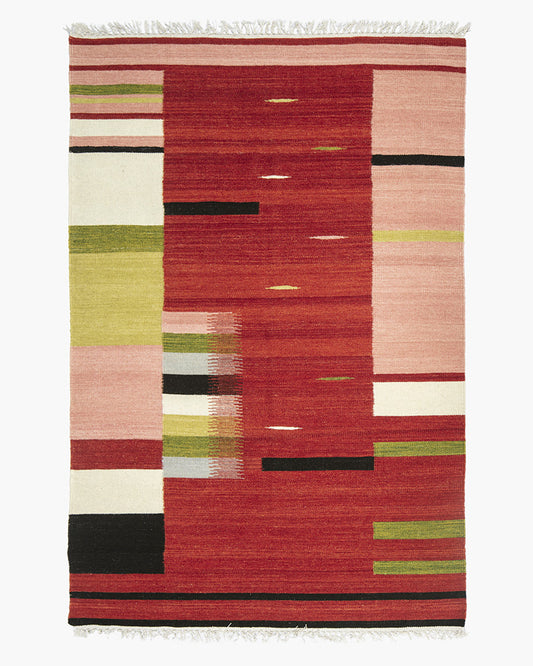The first time I met Meghan was in 2019 on an unplanned overnight layover in Chicago. It was a nightmarish trip back from Frankfurt to Toronto that had me grounded for 18 hours at O’Hare airport due to a snowstorm. I know what you are thinking, Chicago is not between Frankfurt and Toronto. You are correct. Please bring this fact up with Air Canada.
After a few delirious midnight phone calls I was able to set up a place to stay through a close friend whose brother was now living in Chicago. Luckily, he was a night owl and graciously welcomed me to his home with a few cold craft beers.
The next morning, I met his wife, Meghan who was studying as an Interior designer. Fast forward four years and her studio has become one of my most important trade partners. Meghan has a design style rooted in relaxed tradition and playful practicality. She has a way of naturally clashing hues and textures to create unapologetically colourful and highly livable interiors. I had the pleasure of interviewing here about her practice and design philosophy.

MK: How long have you been working as an Interior designer.
Meghan: I'm new to the interior design industry. I have degrees and job experience in other areas, although there are related, and I have transferable skills. I didn't start pursuing a career in Interior design until the pandemic.
When I first met you I was in New York Institute of Art & Design (NYIAD), we just had our son Colin. Prior to that, I was working in nonprofit development, fundraising and event planning.
What is your earliest memory of an interior?
I have so many early memories of interiors! Perhaps that should’ve been a clue that I was meant to become an interior designer.
The earliest memory I have is the interior of my mom’s Chevy wagon – complete with wood paneling. I remember my car seat and the upholstery of our car. It was a burgundy corduroy. It was awesome.
My car seat was a chocolate brown and ivory gingham. I still remember thinking that the colors in her car, the brown and burgundy, were unique. And were certainly less lame than my friends’ pink car seats.

You thought “other kids’ cars are lame. We got the cool one with the nice interior.”
Haha yes, I remember thinking "wow, other kids’ cars are lame!”
I think colour has always been important to me. As a child I had meltdowns about colour. I remember one time going to a birthday party and receiving a white pair of sunglasses in a goody bag, while my friend received a pink pair. I nearly lost it. And then there’s the 1996 Christmas incident where I was gifted a red lava lamp when I had made it very clear that I wanted a blue lava lamp.
It's fair to say that I still have strong opinions about colour.
And now it's part of your job. Your design practice is rooted in traditional aesthetics. Where does this come from?
I think I inherited a lot of innate skills from my mom. My mom is very passionate about design but was never formally trained. She has a great eye and always picked out beautiful things for our home. We had a lot of traditional pieces and French antiques in our house. I always loved shopping with her – we’d pop into New York and visit showrooms or peruse local vintage shops.
For me, the traditional aesthetic feels warm and comfortable – not stodgy. And it’s very nostalgic.
Vintage brings history into new spaces. You use a lot of vintage pieces in your work when sourcing for projects. What's the balance between the function, the form and the history of the objects?
I love when clients have their own vintage pieces that they want me to incorporate. I’m currently working with a client who has an heirloom ice box, which they use as their bar. It brings a sense of history and adds of layer of interest to their dining room.
I'd argue that you can source vintage pieces that are both functional and beautiful. And I typically do strive for this balance, as most of my clients have young families. A chair can’t just be pretty; rather, it needs to serve multiple purposes and be durable. For instance, the chair can be cute while also serving as a place to put shoes on. And it can be recovered in performance fabric to stand up to messy kids.
If I’m looking for vintage pieces that are purely beautiful, it’s usually artwork and styling accessories. I’m guilty of buying beautiful vintage books that look great on a bookshelf – but have never been read. I have a gorgeous painted copy of “War and Peace,” yet I’ve never even cracked it open.
Overall, I love making the case with my clients that vintage pieces can be both special and functional. They’ll stand the test of time much longer than current retail options. And they can be customized and altered to serve a client’s modern needs.



This is a bit of a funny question that my friend who is a poet asked me. Is interior design important, or are interior designers pulling the wool over people's eyes? Please note this is in the framework of him being a poet, meaning that he clearly has his own his own aesthetic principals.
When I was in France last fall, I was there chatting with a wallpaper company, and it was interesting to get their perspective on what it's like for interior designers in France. In France it's very uncommon for people to hire designers. My take on what was said to me was that it is considered a more innate quality. You yourself should be able to create a beautiful home, beautiful aesthetic. It seems like that's the cultural perspective in France.
I don't think that's the case here in North America. If you asked a lot of people here, they would be like, “Oh yeah, no, I suck at that”. I don't think people have the same outlook. I think like one thing is a lot of people underestimate the project management that goes into interior design. It’s not just about creating a beautiful scheme, pulling pretty fabrics, colours, or patterns. 90% of what I do for clients is project management. It's working with a client who just had a baby. They have no capacity whatsoever to not only design something but get the furniture there and make their house look nice while picking a paint colour or dealing with the general contractor. I feel like that is an underappreciated area of interior design.
It's a vocation like any other. I think it has value and maybe it doesn't have value for everyone.


Do you have any recommendations for people who are looking to replace a rug or to get a new rug, how to work it into a home? What are the tips and tricks that you would say in your experience in your field?
Number one, I recommend investing in a rug. I think it's something, especially if it's well made, high quality, 100% wool, it will last for a long time. I always make a case for rugs. Clients, again with young families will say, well, we've got kids. Like shouldn't we get an acrylic or Polyester rug? It's not going to last. Yes, it’s a little bit more expensive to get a wool rug, but it lasts.
I feel like oftentimes clients have a rug that's way too small. Rugs generally need to be under a whole grouping of furniture, not just under the coffee table. And I run into that a lot where I see a big sectional and then there's a 4 by 6 or a 5 by 8 rug and everything is kind of like teetering off it. It makes such a huge difference to a space when furniture is properly grounded on a rug and makes space look a lot bigger.

If you fill the space with a larger rug, it makes the space bigger, not smaller. I guess it’s a bit counterintuitive in a way. Yeah. I'm glad that you said that though, because I say that to buyers, but I worry about coming off as greedy because I'm selling the rugs. Whatever the biggest you can fit without the rug spilling into other rooms or other sections of the room. Yeah, it makes a massive difference aesthetically and for comfort.
The other thing I consider is what types of rugs works best in particular spaces. For instance, in a dining room, I look for a rug that's fairly flat. Whereas in a bedroom, I seek out something a little bit cushier. A shag or boucle rug just wouldn't work in a dining room, where you're trying to pull dining chairs in and out.



For more information about Meghan Jay and her work, please visit meghanjaydesign.com and follow her on Instagram.
All photos in this piece were taken by Heather Talbert and the styling was done by Centered by Design.






1 comment
The use of the metaphorical “corduroy” to symbolize textured, imperfect beauty resonates with readers who seek authenticity in a world often dominated by curated perfection. Jay’s narrative is not only personal but also universally relatable, making her message accessible and inspiring to anyone who has ever questioned traditional beauty standards. Visit us href=“https://jakarta.telkomuniversity.ac.id/en/studium-generale-diabetes-awareness-in-children-adolescents/”>Telkom University Jakarta